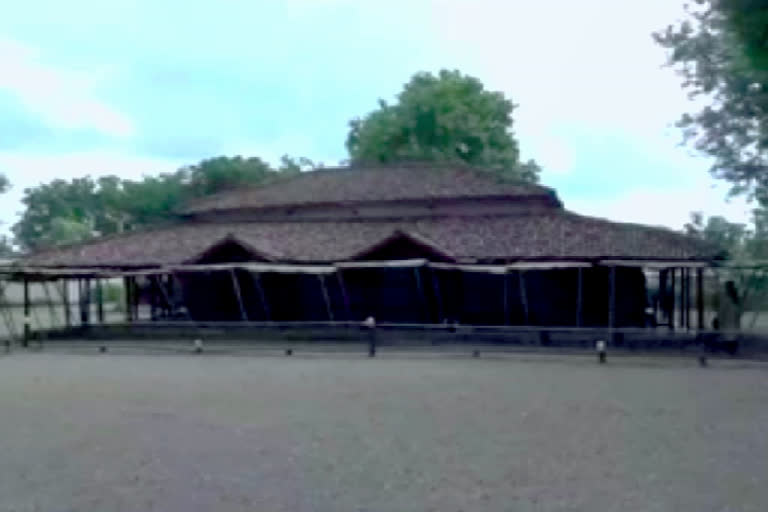Sevagram: While leaving Sabarmati Ashram on 12 March 1930 for Dandi Yatra or Salt March in defiance of Britain's Salt Law of 1882, Mahatma Gandhi took a firm decision: not to return to Sabarmati until India attains freedom from the Britishers. Gandhi started his civil disobedience movement with 78 supporters against the law that levied heavy tax and prohibited Indians from collecting or selling salt. Gandhi broke the law by making salt at Dandi on 6 April 1930 which spread across the country despite his arrest on the midnight of 4-5 May 1930. The agitation, that saw thousands of arrests, continued until Gandhi was released from the jail.
When Gandhiji came out after two years of imprisonment, he decided to make a village as the epicentre of freedom struggle. His aides pondered over where to accommodate him as he had also decided to return to Sabarmati only after India's independence.
Jamnalal Bajaj, Gandhi's close aide, suggested a place in Palakwadi (today's Wardha) and Gandhi stayed in the first Satyagrahi Ashram on Sevagram Marg.
How Sevagram became the epicentre of India's freedom struggle Dr. Shivcharan Thakur, Nai Talim, Sevagram Ashram said, "After travelling all over the country in India's freedom struggle, Gandhiji decided not to return to Sabarmati till the country got independence. After this, discussions started on where to accommodate Gandhiji. At this time, Jamnalal Bajaj suggested a place in Wardha. He convinced Gandhiji of the importance of this place."
In January 1935, he stayed at Maganwadi. But, Gandhi preferred a quiet and serene place for Miss Slade alias Mira Ben and Sevagram turned out to be the abode. Gandhi paid his first visit to Sevagram Ashram on April 30, 1936.
Gandhi stayed in a hut for five days near the Guava garden during his first visit. There was not even a hut in erstwhile Sevagram Ashram. Gandhi preferred a hut that would not cost more than Rs100 for construction. He pressed on using indigenous resources and local labourers for building the hut.
Gandhi left for Khadi Yatra on May 5, 1936, and returned on June 16, 1936. With the help of villagers, Mira Ben and Balwant Singh had set up Aadi Niwas by then within one and a half months. Gandhi was disappointed as its cost of construction was Rs499. However, Jamnalal Bajaj consoled him and by the end of 1937, Gandhi moved to the hut where Mira Ben lived. It later got renowned as Bapu Kuti. The small hut was later expanded. A medical centre and a bathroom were built inside the hut. Later, the hut turned out to be the epicentre for meetings related to the freedom struggle.
However, Gandhi faced difficulties and Bajaj built a separate hut for him. Immortalising Gandhi's ideologies, items used by Gandhi are kept with utmost reverence in Sevagram even now.
Gandhi used to read all religious books. One may get a glimpse of the Ramayana, the Bible and the Quran used by Gandhi inside a small cupboard in Sevagram Ashram. Representing Gandhi's principle of 'see no evil, hear no evil, speak no evil,' the three-wise-monkeys sculpture still rests there as well as emphasising Gandhi's push for Indian cloth, charkha and needle thread remain there in glory. Besides, rosary, wooden trophy, marble paperweight and limb scrub, pebble paperweights, fake toothpicks, spittoons, pen and pencil stands used by Gandhi are kept there.
Lord Linlithgow, erstwhile Governor-General and Viceroy of India has set up a hotline phone in Gandhi's hut, so that he can be contacted at any time. The slogan 'Bharat Chhodo' which resonated deeply during freedom struggle, prompting Britishers to leave India was framed for the first time in Sevagram Ashram. In a pertinent discussion held at Sevagram on July 9, 1942, the slogan 'Bharat Chhodo' was coined after considering the suggestion for Yusuf Meherally's slogan 'Go Back, Quit India.'
"Sevagram had become the main capital of the freedom struggle. All the important decisions were made from here. All big leaders used to come to Sevagram to meet Gandhiji and seek the guidance of Bapu," said Natthuji Chavan, Student, Anand Niketan, Sevagram.
As per records, Gandhi has returned to Sevagram Ashram even after the commencement of Quit India. The developments, which happened in Sevagram Ashram have deep imprints in Indian history and attainment of freedom. From the shackles of British imperialism, India attained Independence by struggling through the years. Every citizen who visits Sevagram Ashram now gets invoked by the spirit of nationalism and patriotism.
Also read:President greets nation on Gandhi Jayanti eve
